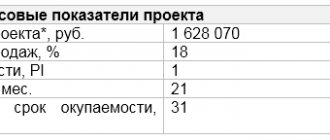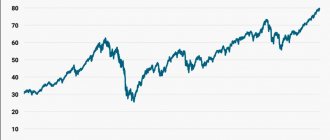- Denomination of Russian money
- Coins of Russia
- Commemorative coins
- Commemorative banknotes
The history of modern banknotes of the Russian Federation dates back to January 1, 1998, when, as a result of monetary reform, three zeros disappeared from Bank of Russia notes. For the new banknotes, the design of the 1995 series was used without any changes other than the denomination. The exception is the 1000 ruble bill that has left circulation and has been replaced by a ruble coin. The design of the coins preserves the traditions of previous years. On the obverse is the emblem of the Bank of Russia. On the reverse there is a designation of the denomination in a specialized font, first used in 1991 back in the USSR (“GKChP coins”). What kind of money is now required to be accepted in Russia? Let's look at both banknotes and coins.
Denomination of Russian money
Currently, the series of 1997 banknotes includes denominations of 10, 50, 100, 500, 1000 and 5000 rubles. In addition, the Bank of Russia 5 ruble , the issue of which has long been discontinued, remains legal tender. The 2020 series of banknotes so far consists of two denominations - 200 and 2000 rubles . However, it is planned to expand it in the future. Also legal tender are commemorative banknotes of the Bank of Russia with a hundred-ruble denomination.
The line of everyday coins consists of 1, 5, 10 and 50 kopecks , as well as 1, 2, 5 and 10 rubles . The last mass circulations of 1 and 5 kopeck coins were recorded in 2014. Among numismatists, the slang name for these coins with the date “2014” is “Crimean kopeks”. Coins in denominations of 10 and 50 kopecks are not minted after 2015.
Monetary circulation is also ensured by commemorative coins in denominations from 1 to 10 rubles. Their characteristics correspond to ordinary circulating coins. The exception is bimetallic 10 rubles. In addition, for commemorative issues since 2011, a denomination of 25 rubles has been used, which does not yet have a common analogue.
Historical data on money in Ukraine
Previously, on Ukrainian lands, our ancestors used Greek coins. Later, the money of the Roman Empire appeared, which was used to accumulate wealth and produce jewelry. Thanks to trade relations with foreign merchants, the currency spread to Podolia, Prykarpattya, Transnistria and other areas. Due to the economic and political crisis in the Roman state that arose in the 3rd century, ties were terminated. In the 5th-7th centuries, Byzantine and Arab currencies came into circulation.
During the rule of Vladimir Svyatoslavovich (918-1015), the history of money in Ukraine was supplemented by a new event: they began to produce the oldest coins - silver coins (weight up to 4.68 g) and zlatniks (weight 4.4 g). They were marked with an image of the prince on the throne with a trident, which was the family sign of the Rurikovichs. At the end of the 11th century, the first “hryvnia” made of silver appeared.
In the middle of the 18th century, Ukraine was part of the Russian Empire, and therefore its monetary system completely changed. The modification of the currency complicated the relations of residents of the former state with other countries. After the proclamation of the Ukrainian People's Republic (1917), it was decided to introduce paper hryvnias into circulation, which became the legal national currency in 1996.
Coins of Russia
In preparation for the monetary reform, several design options for ruble coins were considered. On test copies, the denomination designation is centered, the floral ornament is placed behind the number. Since 2020, the State Emblem of the Russian Federation has been used on the obverse instead of the emblem of the Bank of Russia. Coins from 1997 to 2020 are not withdrawn from circulation and remain legal tender.
Denomination – 1 ruble. Diameter - 20.5 mm. The standard thickness is one and a half millimeters. Weight - 3.25 grams (1997-2009 copper-nickel alloy) or 3 grams (since 2009 galvanized steel). Coins of 2014 with a graphic sign of the ruble instead of a unit are considered commemorative, but they do not represent value due to the circulation of 100,000,000 pieces.
Denomination: 2 rubles. Diameter - 23 mm. The standard thickness is 1.8 mm. Weight - 5.1 grams (1997-2009 copper-nickel alloy) or 5 grams (since 2009 galvanized steel).
Denomination: 5 rubles. Diameter - 25 mm. The standard thickness is 1.8 mm. Weight - 6.45 grams (1997-2009 copper clad with cupronickel) or 6 grams (since 2009 galvanized steel). At the beginning of 1998, a dollar was worth a little over six rubles, making 5 rubles the most counterfeited coin of that period.
Denomination: 10 rubles. Diameter - 22 mm. The standard thickness is 2.2 mm. Weight – 5.63 grams (galvanized steel). At the very beginning of its operation (late 2009), the Russian population mistakenly mistook this coin for a commemorative coin and began saving it in reserve. Even the recommendation and explanatory letters from the Bank of Russia did not help, stating that the coin had no collection value. Therefore, we had to temporarily resume printing paper tens.
According to the plan of the Bank of Russia, the obverse of the kopecks should represent the sights of the country (the monument to Minin and Pozharsky, the monument to the 1000th anniversary of Russia, the Golden Gate in Vladimir). However, before the reform itself, they decided to unify the drawing. They also abandoned the minting of the two-kopeck denomination. On the obverse of circulation copies we see the image of St. George the Victorious. Since 1997, there have been no changes in the design of coins. Currently not minted, but remain legal tender. For 2020, nothing is known about any plans to resume the minting of penny coins.
Denomination – 1 kopeck. Diameter - 15.5 mm. The standard thickness is 1.25 mm. Weight - one and a half grams (steel clad with cupronickel). The coin is only half a millimeter larger than the similar denomination of the USSR, but one and a half times heavier.
Denomination: 5 kopecks. Diameter - 18.5 mm. The standard thickness is 1.45 mm. Weight - 2.6 grams (steel clad with cupronickel). There are known coins from 2008 with galvanic coating. Almost the same small patches (15.1 mm) were minted in Tsarist Russia, but consisted of 500-carat silver. The rarest coin is the only known copy of 5 kopecks from 1999 SP.
Denomination: 10 kopecks. Diameter - 17.5 mm. The standard thickness is 1.25 mm. Weight - 1.95 grams (1997-2006 brass) or 1.85 grams (since 2006 steel with plating or coating). Since the time of Paul I, the diameter of the ten-kopeck denomination has invariably been close to 17 millimeters.
Denomination: 50 kopecks. Diameter - 19.5 mm. The standard thickness is one and a half millimeters. Weight - 2.9 grams (1997-2006 brass) or 2.75 grams (since 2006 steel with plating or coating). This is one of the smallest domestic fifty dollars. 50 kopecks with a smaller diameter (18 mm) were briefly minted only in 1991 before the collapse of the USSR.
Paper money
Paper money is banknotes (bank notes). This monetary instrument appeared in the Middle Ages; its main purpose was to confirm the safety of a certain amount of gold in a bank. The bank kept records of gold, which over time could be returned to the owner at his request. Such banking settlements became popular over time. After some time, central banks gained the right to independently issue banknotes. A little later, state banks appeared, and the government took full responsibility for issuing banknotes. Initially, banknotes were exchanged for gold bars; their issue was entirely dependent on the gold reserves in the state. Since the 20th century, most of the world's countries have suspended the exchange of banknotes for gold, and the issue of paper money began to be controlled by other requirements.
Therefore, the main purpose of paper money is to replace gold in circulation. Paper money does not have its own personal price; it is put into circulation by the state, which sets a forced exchange rate for it. Moreover, this exchange rate is valid only within a certain country. The real value of paper money is determined by special circulation laws that do not depend on government power. Such money is in circulation in accordance with the law. When the issue of paper money significantly exceeds the needs for trade turnover, it begins to depreciate. This mainly happens when prices rise, followed by inflation.
Paper money also includes treasury notes, which are issued to cover government expenses by the Ministry of Finance. Treasury notes are not exchangeable for gold bullion.
At the moment, paper money is considered a commodity and is divided into commodity and decreed. This role was assigned to them by the state itself. The money that is characterized by an internal price is called commodity money, the rest is decreed.
Commemorative coins
Denominations of 2, 5 and 10 rubles have an obverse, where the name of the issuer and the mint mark are combined with the denomination designation. The ruble denomination has a standard obverse. The reverse of the coins was used to mark a memorable event.
Denomination: 10 rubles (bimetal). Diameter - 27 mm. The standard thickness is 2.1 mm. Weight – 8.4 grams (1997-2016, insert – cupronickel, ring – brass, since 2020 coated steel). There are known experimental coins from 2013 (“North Ossetia – Alania”) with pronounced magnetic properties. In the same issue, a non-standard edge is noted (180 corrugations instead of three hundred). Among the bimetallic commemorative coins, there are two large series - “Ancient Cities of Russia” and “Russian Federation” (“Regions of Russia”).
Denomination: 25 rubles. Diameter - 27 mm. The standard thickness is 2.3 mm. Weight – 10 grams (nickel silver). Some coins are issued in small editions with color designs. Color issues are intended for collectors, since any of the copies at the initial sale is already significantly more expensive than face value. For 5,000 rubles, a non-colored 25 rubles 2020 “Give Kindness to Children” was sold.
Commemorative banknotes
Unlike everyday ones, commemorative banknotes have a vertical design.
Denomination: 100 rubles. Dimensions - 150x65. The predominant color is blue. A memorable event is the Sochi 2014 Olympics. The design includes a snowboarder, Olympic venues in Sochi, the Fisht stadium and the firebird. There are known series of banknotes with the letters AA, aa and Aa (replacement series), as well as PP (sample).
Denomination: 100 rubles. Dimensions - 150x65. The predominant color is olive green. A memorable event is the return of Crimea to Russia. The design includes a monument to sunken ships, a fragment of a painting by I.K. Aivazovsky “Russian squadron on the Sevastopol roadstead” and the decorative castle “Swallow’s Nest”. There are known series of banknotes with the letters KS, SK and KS (replacement series), as well as NN (sample). This banknote is also prohibited for acceptance and exchange on the territory of Ukraine.
Denomination: 100 rubles. Dimensions - 150x65. The predominant color is blue-green. A memorable event is the FIFA World Cup in Russia. The design features a boy with a ball in his hand, goalkeeper Lev Yashin in a jump and a stylized image of the globe in the form of a soccer ball. There are known series of banknotes with the letters AA and AB.
Buy coins in an online store Sell coins in Moscow Sell coins in St. Petersburg
Latest auction prices for coins in Russian rubles
| Photo | Description of the coin | G | VG | F | VF | XF | AU | UNC | Proof |
| 1 kopeck 1997 M from 15 to 110 rubles. | — | — | 15 | — | 110 | — | 62 | — | |
| 50 kopecks 1997 M about 308 rubles. | — | — | — | — | — | — | 308 | — | |
| 1 ruble 1997 SPMD from 21 to 433 rubles. | — | — | — | 21 | 178 | — | 433 | — | |
| 2 rubles 1997 SPMD about 450 rubles. | — | — | — | — | — | — | 450 | — | |
| 5 rubles 1997 SPMD about 293 rubles. | — | — | — | — | — | — | 293 | — | |
| 5 kopecks 1999 SP | — | — | — | — | — | — | — | — | |
| 10 rubles 2009 MMD from 200 to 378 rubles. | — | — | — | — | 378 | 200 | — | — | |
| 10 kopecks 2009 SP | |||||||||
History and evolution
Historically, money appeared only after a problem with the exchange of goods was identified. Previously, in order to get what they wanted, people offered to exchange one thing for another. If a primitive man needed a tool, he had to find someone who had it and who would be able to make a counteroffer.
Since the life of the ancestors was difficult, and clothing, food, and household items were obtained through hard work, goods were rarely produced not for personal use, but for sale. Only after hunting and berry-picking faded into the background and people began raising livestock and growing crops did surplus produce appear. The tribes traded animal meat for grain. This is how barter was born.
The first money was not like the usual banknotes. The form of currency, depending on the region of use, was:
- pebbles;
- tea leaves;
- tobacco;
- salt;
- cocoa beans;
- shells;
- ivory and wool.
History knows examples when it was possible to pay for goods with cattle or fish. “Fur” money was present in Siberia. In fact, one could pay with the skins of animals. It is interesting that this form of currency was used on the farm according to its intended purpose. In countries where deposits of silver and gold were found, these metals were used, acting as money. Thus, according to information about historical excavations in ancient Mesopotamia, that is, 3.5 thousand years BC, silver was one of the forms of currency.
It was only in the 18th and 19th centuries that people stopped mining gold to satisfy their trading needs. A different payment system has emerged. Governments of various countries began to issue paper money. Each banknote had its own denomination. Banks operated by issuing credit money. This is how money circulation was formed.
Now money is credited with 4 functions. They act as a measure of value, are a means of payment, are constantly in circulation and can be a means of accumulation.
Modern money has the form:
- coins;
- paper bills;
- non-cash deposit;
- electronic (digital);
- virtual.
The emergence of a universal means of payment has had a positive impact on society. Digital money is gradually replacing paper bills and coins. They are endowed with a high degree of security. This provokes constant public demand for cards with a computer chip that store information about the account status of its owner. Unlike paper money, electronic money is much more difficult to steal. The most modern type of currency is virtual money. Unlike all the others, they are not provided with anything, and their number is limited by the code embedded in the algorithm. Moreover, anyone can produce them.
Digital and virtual money exchange expand the boundaries of the concept of money as a medium of exchange - it no longer has a material form, but real things can be purchased with it. Owners of electronic wallets (WebMoney, Yandex.Money, Oiwi), as well as those who know how to earn bitcoins using computer programs, can pay their bills and make purchases without leaving home. The electronic payment system is gaining new momentum.











